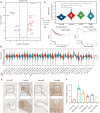OTUB2 promotes proliferation and metastasis of triple-negative breast cancer by deubiquitinating TRAF6
- PMID: 40296903
- PMCID: PMC12034018
- DOI: 10.32604/or.2025.062767
OTUB2 promotes proliferation and metastasis of triple-negative breast cancer by deubiquitinating TRAF6
Abstract
Objectives: Deubiquitinase OTUB2 plays a critical role in the progression of various tumors. However, its specific role in triple-negative breast cancer (TNBC) remains unclear. This study aims to elucidate the biological function of OTUB2 in TNBC and uncover the underlying mechanisms.
Methods: First, we found that the expression of OTUB2 was upregulated in TNBC by bioinformatics analysis, we then validated its expression in TNBC tissues and cells using immunohistochemistry (IHC) and qPCR and plotted the survival curves by Kaplan-Meier method. Gene set enrichment analysis (GSEA) suggested that OTUB2 may be involved in tumor proliferation and metastasis. Further functional assays, including Cell Counting Kit-8 (CCK-8), colony formation, Transwell, and wound healing assays, were performed to assess the effects of OTUB2 overexpression and knockdown on TNBC cell proliferation and migration. Additionally, UbiBrowser 2.0 was used to identify OTUB2 substrate proteins and western blotting was conducted to clarify the molecular mechanisms involved.
Results: Our results demonstrated that OTUB2 expression was elevated in TNBC and associated with poor prognosis. Overexpression of OTUB2 enhanced the proliferation and migration of TNBC cells, while its knockdown inhibited these processes. Moreover, OTUB2 stabilized tumor necrosis factor receptor-associated factor 6 (TRAF6) by deubiquitinating it, leading to activation of the protein kinase B (AKT) pathway.
Conclusions: OTUB2 exerts its promoting effects on the progression of TNBC by activating the TRAF6/AKT pathway.
Keywords: Deubiquitination; OTUB2; Triple-Negative Breast Cancer (TNBC); Tumor necrosis factor receptor-associated factor 6 (TRAF6).
© 2025 The Authors.
Conflict of interest statement
The authors declare no conflicts of interest to report regarding the present study.
Figures






Similar articles
-
Exploring the regulatory role of FBXL19-AS1 in triple-negative breast cancer through the miR-378a-3p/OTUB2 axis.Cell Biochem Funct. 2024 Jun;42(4):e4020. doi: 10.1002/cbf.4020. Cell Biochem Funct. 2024. PMID: 38702967
-
OTU deubiquitinase, ubiquitin aldehyde binding 2 (OTUB2) modulates the stemness feature, chemoresistance, and epithelial-mesenchymal transition of colon cancer via regulating GINS complex subunit 1 (GINS1) expression.Cell Commun Signal. 2024 Aug 29;22(1):420. doi: 10.1186/s12964-024-01789-2. Cell Commun Signal. 2024. PMID: 39210373 Free PMC article.
-
The deubiquitinase BRCC3 increases the stability of ZEB1 and promotes the proliferation and metastasis of triple-negative breast cancer cells.Acta Biochim Biophys Sin (Shanghai). 2024 Apr 25;56(4):564-575. doi: 10.3724/abbs.2024005. Acta Biochim Biophys Sin (Shanghai). 2024. PMID: 38449391 Free PMC article.
-
OTUB2 stabilizes U2AF2 to promote the Warburg effect and tumorigenesis via the AKT/mTOR signaling pathway in non-small cell lung cancer.Theranostics. 2019 Jan 1;9(1):179-195. doi: 10.7150/thno.29545. eCollection 2019. Theranostics. 2019. PMID: 30662561 Free PMC article.
-
Deubiquitinase MYSM1: An Important Tissue Development and Function Regulator.Int J Mol Sci. 2024 Dec 4;25(23):13051. doi: 10.3390/ijms252313051. Int J Mol Sci. 2024. PMID: 39684760 Free PMC article. Review.
Cited by
-
IGLL5 has potential to be a prognostic biomarker and its correlation with immune infiltrates in breast cancer.Am J Clin Exp Immunol. 2025 Jun 15;14(3):111-126. doi: 10.62347/XLCY5727. eCollection 2025. Am J Clin Exp Immunol. 2025. PMID: 40689316 Free PMC article.
References
-
- Hermansyah D, Firsty NN, Siagian RHN, Dwinda NN. Intercontinental comparison of immunohistochemical subtypes among individuals with breast cancer in South-East Asia and South America: a scoping systematic review and meta-analysis of observational studies. World J Oncol. 2024;15(3):355–71. doi:10.14740/wjon1788. - DOI - PMC - PubMed
MeSH terms
Substances
LinkOut - more resources
Full Text Sources
Research Materials
